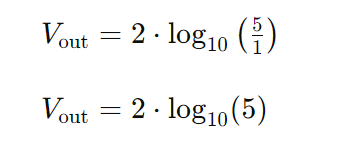Log Amplifier Voltage Calculator
Introduction: A log amplifier voltage calculator is a useful tool for engineers and electronics enthusiasts to determine the output voltage of a log amplifier circuit based on the input voltage and specific parameters. This article presents a convenient calculator along with an explanation of its usage and formula.
How to Use: Simply input the required parameters into the designated fields and click the “Calculate” button to obtain the result. The calculator will provide the output voltage based on the entered values.
Formula: The formula used for calculating the output voltage of a log amplifier is:

Where:
- Vout is the output voltage.
- Vin is the input voltage.
- Vref is the reference voltage.
- V0 is the gain factor.
Example Solve: Suppose we have an input voltage of 5V, a reference voltage of 1V, and a gain factor of 2. Plugging these values into the formula:

Using a logarithmic calculator, we find log10(5) to be approximately 0.69897.
V out=2⋅0.69897
V out=1.39794
Therefore, the output voltage Vout is approximately 1.39794 volts.
FAQs: Q: What is a log amplifier?
A log amplifier is a type of amplifier circuit that outputs a voltage proportional to the logarithm of its input voltage.
Q: Why is a log amplifier useful?
A log amplifier is useful in applications where a wide dynamic range of input voltages needs to be compressed into a smaller range for analysis or display.
Conclusion: In conclusion, a log amplifier voltage calculator simplifies the process of determining the output voltage of a log amplifier circuit. By inputting the necessary parameters, users can quickly obtain accurate results, aiding in the design and analysis of electronic circuits.